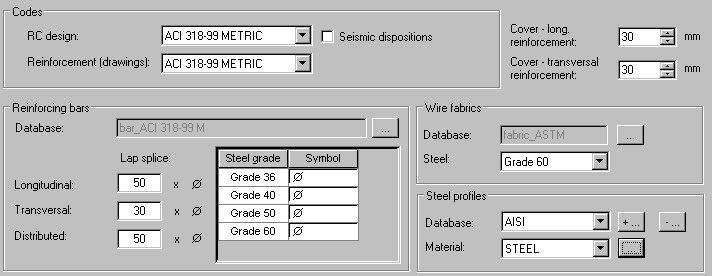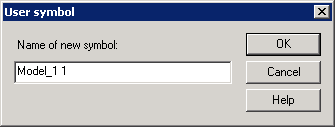After selecting the Codes -> Materials option from the selection tree located in the Job Preferences dialog, the following options display:

In the Codes field, you select the code for RC structure design and drawings (drawings of reinforcement). A selected drawing code displays the appropriate symbols of designation, hatching, etc. valid in a given country whose code is currently in use. The following codes are available:
- RC design:
- American code ACI 318-08/M
- British code BS 8110
- Eurocode 2
- Eurocode 2 (Italian NAD)
- French code BAEL 99
- Belgian code NBN B 15-002
- Polish codes: PN-84/B-03264 and PN-B-03264:1999
- Romanian code STAS 10107/0-90
- Russian code SNiP 2.03.01-84
- Ukrainian code DSTU 3760-98
- Spanish code EHE 98
- Norwegian code NS 3473E: 1999
- Italian code DM 9/96
- South African code SABS 82: 1997
- German code DIN 1045
- Swedish code BBK 04
- Danish code DS 411
- Austrian code ONORM B 4700
- Indian code IS 456: 2000
- Singaporean code CP65
- Drawing codes: (corresponding to appropriate RC code):
- American code ACI 318-08/M
- British code BS 8666: 2000
- Eurocode 2
- Eurocode 2 (Italian NAD)
- French code NF P 02-016
- Belgian code NBN B 15-002
- Polish code PN-ISO 4066:1194
- Romanian code STAS
- Russian code GOST 21.501-93
- Spanish code EHE 98
- Norwegian code NS 3473
- Italian code DM 9/96
- South African code SABS 82: 1997
- German code DIN 1045
- Swedish code BBK 04
- Singaporean code CP65.
The Codes field also contains the Seismic dispositions option. It effects the length of reinforcing bar hooks and of lap splices in longitudinal bars; in the reinforcing bar databases, for French and Romanian codes there are additional columns containing hook lengths available if seismic dispositions are active. If the Seismic dispositions option is selected, then hook lengths are taken from this additional column in which seismic effects are considered (if seismic dispositions are active, hook lengths are increased approximately twice depending on the code). Values of lap splices are increased by 30% in relation to those defined in the preferences.
In the Reinforcing bars field, you select steel classes for the relevant reinforcement type from the selected database of reinforcing bars; a steel class is assigned a symbol corresponding to it. The drop-down lists contain steel symbols (they depend on a selected code).
Steel classes available on the selection lists correspond to the chosen database of reinforcing bars; to change the reinforcing bar database (the field in which the file name is presented in inaccessible), click the (...) button located next to the Database field and in the Open dialog to indicate appropriate database file (*.xml). It results in adapting the reinforcement parameters to the user needs.
On the unfolding list, graphical symbols are displayed.
Below the list of standard steel designations is presented:
![]() .
.
At the end of this list is the User symbol option. Selecting this option opens the User symbol dialog where you can define and modify an appropriate diameter of a symbol.

For reinforcing bars, you may select a lap splice for longitudinal, transversal and distributed reinforcement; the lap splice length is adopted as a multiple of a reinforcing bar diameter.
The Wire fabrics field enables selection of steel classes from the chosen wire fabric database. Steel classes available on the selection lists correspond to the selected wire fabric database. To change the wire fabric database (the field in which the file name is presented in inaccessible), click the (...) button located next to the Database field and in the Open dialog indicate the appropriate database file (*.xml). It results in adapting the wire fabric parameters to the user needs.
In the upper part of the dialog a value of a reinforcement cover is specified: separately for longitudinal bars (reinforcement - elevation), and separately for transversal bars (reinforcement - section). A cover value for longitudinal reinforcement given in the edit fields is used while defining reinforcement - elevation and special reinforcement, whereas a value of the transversal reinforcement cover is used when defining reinforcement - section.
The Steel profiles field allows selection of steel profile databases. To add a new profile database to the list of active profile databases, click ‘+’, and select a steel profile database. A profile database can be deleted from the list of active profile databases; by selecting a profile database from the list and clicking ‘-’.
The Steel profiles field also allows selection of materials for steel profiles. Materials found on the selection list correspond to selected materials from a material database. To add a material to the list click (...) located next to the Material field, and select an appropriate material in the Material database dialog.